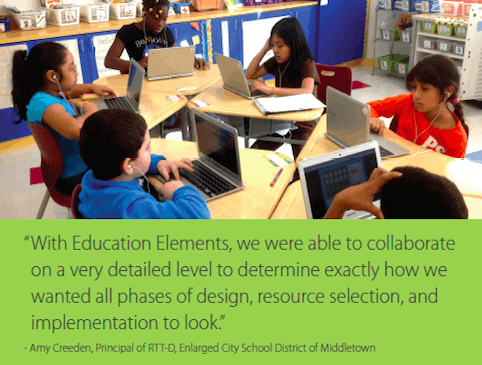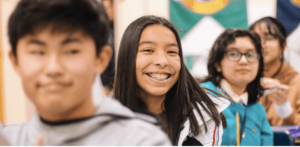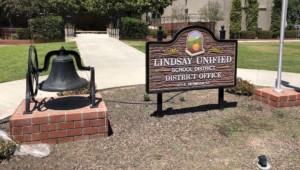21st Century Education: Not Just Relationships, But Also Partnerships and Personalization

By: Dr. Kenneth W. Eastwood
In an August 16, 2014 New York Times OpEd piece, “Teaching is Not a Business,” David Kirk argues that while the solutions education reformers and businesses are touting focus on the “impersonal, whether it’s the invisible hand of the market or the transformative power of technology…” there is no evidence that this approach is working. Rather, Kirk concludes, “the process of teaching and learning is an intimate act that neither computers nor markets can hope to regulate… There is simply no substitute for the personal element”.
If only, it was that “simple.”
Yes, the teaching and learning process is human and intimate. Yes, it is complicated and messy. It has, for a number of years, become significantly more complex and difficult as the range or variance of student ability levels in the typical classroom has doubled and tripled, making the teacher’s job significantly more difficult, if not, in some circumstances, almost impossible.
Therein lies the value from partnering with business, leveraging the strengths and values of technology, and looking to new instructional models that seek to personalize the educational process and incorporate technology in dynamic and productive ways.
Who cares who or what organization or business developed the solutions and whether they are considered disruptive or not as long as they have the ability to help teachers manage and guide the instructional success for each of their students regardless of ability levels? Why argue around the extremes when we should be encouraging greater educational entrepreneurialism? I have never met a teacher who did not want to be more efficient and effective. At the same time, however, they also did not want to be the subject of instructional time depreciation from fly by night initiatives driven by whatever hot programs a new superintendent or Board of Education wants to implement. Teachers want stable, legitimate solutions that will help them over the long haul to be more efficient and effective educators while their students become more successful learners.
I do not believe that businesses will fix broken schools. As Superintendent of a mid-sized school district in New York, I believe our leadership team, building administrators and teachers will fix them. But I do not think we will do it alone. I do though think, businesses and new instructional models, will play a critical role in making our schools better.
Middletown, New York has 7,000 students of which nearly 75% receive Free or Reduced Lunch. Like many districts across the country, our student achievement rates are lower than is acceptable, our high school graduation rate is lower than we can tolerate, our college persistence and completion rates are not where we want them to be.
Also like many districts, we understand the root of the problem and that tinkering around the edges will not solve it. For our students to learn, we need to teach and reach each one individually. Incremental programs will not change a student’s trajectory, but large-scale transformation of teaching and learning will.
In the first year of the US Education Department’s Race to the Top – District competition we won $20M based on our application to personalize learning for every student. Since then we have embarked on a journey, alongside several for-profit organizations, to radically change what we do in our classrooms on a daily basis. With one school year behind us, and tremendous results to show, we have no regrets.
I would like to invite Dr. Kirk, and anyone for that matter, to our district to see, if the use of business partnerships, technology and/or new instructional models are impersonal. The work we have done, alongside our business partners, is all about making education as personalized as possible.
Without business partners, we could not fully integrate technology into our classrooms. Without technology, it is not possible to personalize learning in a sustainable and scalable way. And if we could not make it scalable and sustainable, it would not have resulted in the significant positive transformation that has caused Dr. Dale Mann, an internationally recognized expert in school improvement to state:
“The accomplishments of Middletown’s administrators, teachers, students, and communities are a significant and encouraging departure from the otherwise unlikely prospect of turning around public schools. Middletown, despite several challenges and barriers to success, is a documented example of a turnaround school district.”
How did we turn around our high-needs, high-poverty/minority school district? We worked with a number of companies, from Education Elements for their consulting services and platform to iReady, Dreambox, Achieve3000, Lexia and MyOn for their digital content, in order to drive student achievement. The data, provided by the digital content and formative classroom assessments, allows our teachers to be champions with focus and to be able to celebrate all of the incremental successes that students make. They would not have the ability to be as prescriptive and diagnostic about their feedback without the data.
We focused on goal-setting. With the assistance and support of our partners we helped teachers to create goals for themselves and helped them learn to work with students to develop their learning goals as well. I can’t tell you how many classroom visits I’ve made over the past year where I ask the question “Can I see you goal sheets?” “Tell me…how are the conversations with students, about their goals, going?” We focused on this in our professional development workshops in all of our follow-up conversations. We saw the earliest and biggest gains from teachers who were doing a really authentic job of “goal setting,” and other teachers followed suit.
Our teachers have more time to focus on each student. They have more time to focus on deeper learning and critical thinking. They have more time to deepen relationships, to know what makes individual students tick. Our teachers have more time to focus on the personal. More time made possible by the technology we put in place which allowed them to restructure their use of time and space as a result.
David Kirk said these ideas sound good in a think tank but do not work in a school district. As the Superintendent of an average-size district, in the middle of a state, with a socioeconomically and racially diverse population I can tell you, that bold-disruptive ideas can work anywhere if you implement them correctly and if you have the right partners on your side.
How do I know? Our teachers report that students are more engaged. They say they have more time to differentiate instruction, and that learning is accelerated. Our graduation rate has climbed thirty percentage points and overall test scores have steadily increased. Students in classrooms where we implemented personalized learning have outperformed students in the ones where we didn’t, gaining 35% more in Reading and 47% more in Math on NWEA benchmark exams.
Let’s drop the debating at the extremes and move to a more inclusive discussion on how relationships, partnerships, technology, new strategic instructional models, and whatever else it takes makes teaching and learning more effective and efficient for all.
On that premise, there is no need to debate, but to “simply” get to work.
 Dr. Kenneth W. Eastwood is Superintendent of Middletown City School District in New York.
Dr. Kenneth W. Eastwood is Superintendent of Middletown City School District in New York.







0 Comments
Leave a Comment
Your email address will not be published. All fields are required.